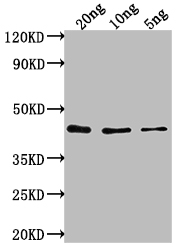The production of the Htra1 polyclonal antibody is a systematic process that begins with the repeated immunization of a rabbit using recombinant mouse serine protease Htra1 protein (141-480aa). This immunization continues until a sufficient antibody titer is achieved. Subsequently, the rabbit's blood is collected, and the antibodies are purified from the serum using protein A/G. The functionality of the resulting Htra1 antibody is rigorously assessed in ELISA and WB applications, confirming its specific reactivity with the mouse Htra1 protein.
In the extracellular space, Htra1 functions as a serine protease that degrades a number of proteins and extracellular matrix molecules. It contributes to protein quality control, recognizing and cleaving abnormal proteins into smaller fragments to prevent misfolding and mislocalization. Intracellularly, Htra1 is involved in tumor suppression and cell proliferation and migration. Htra1 thus plays a role in several diseases such as macular degeneration, arthritis, and CARASIL.







